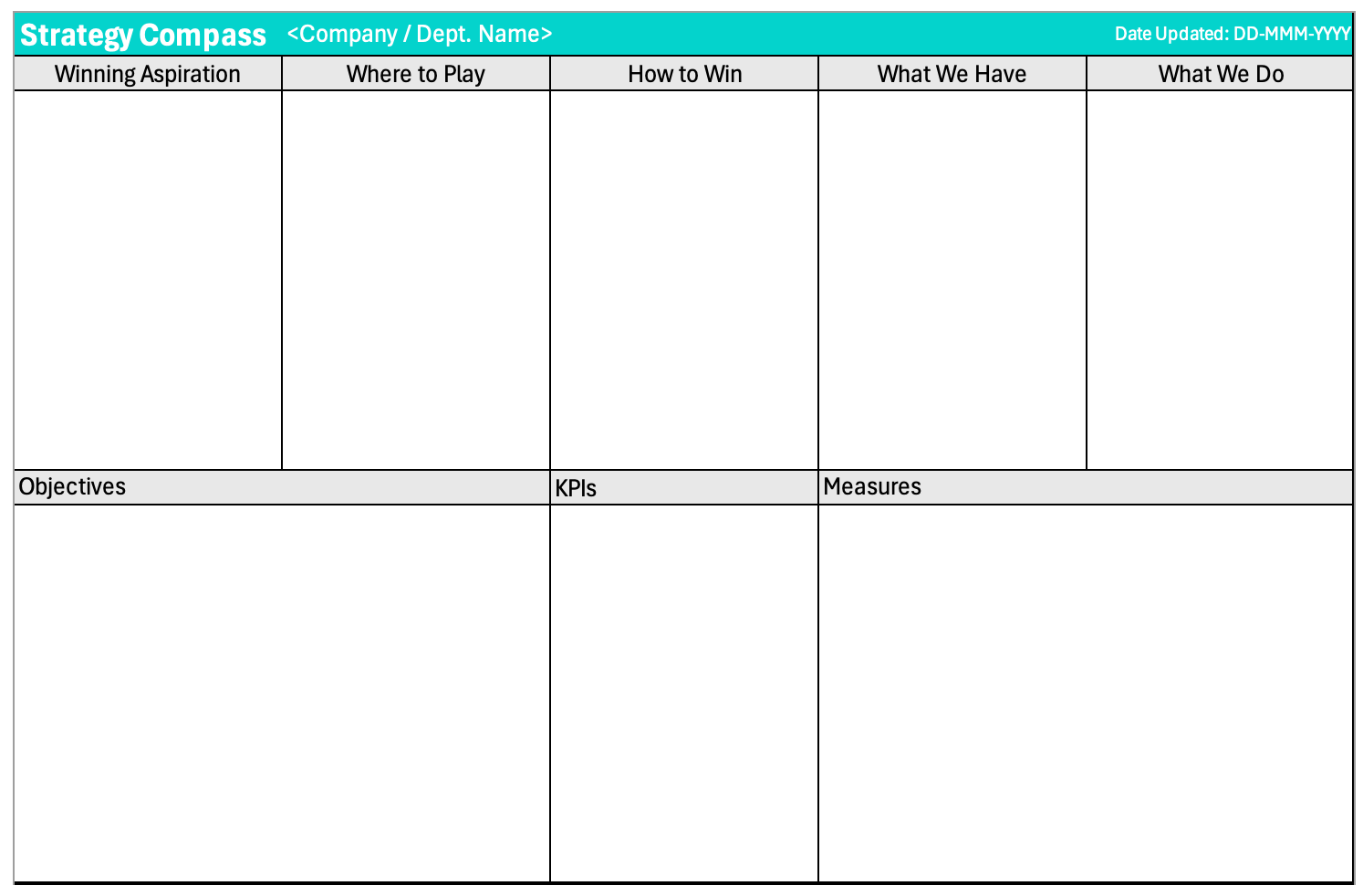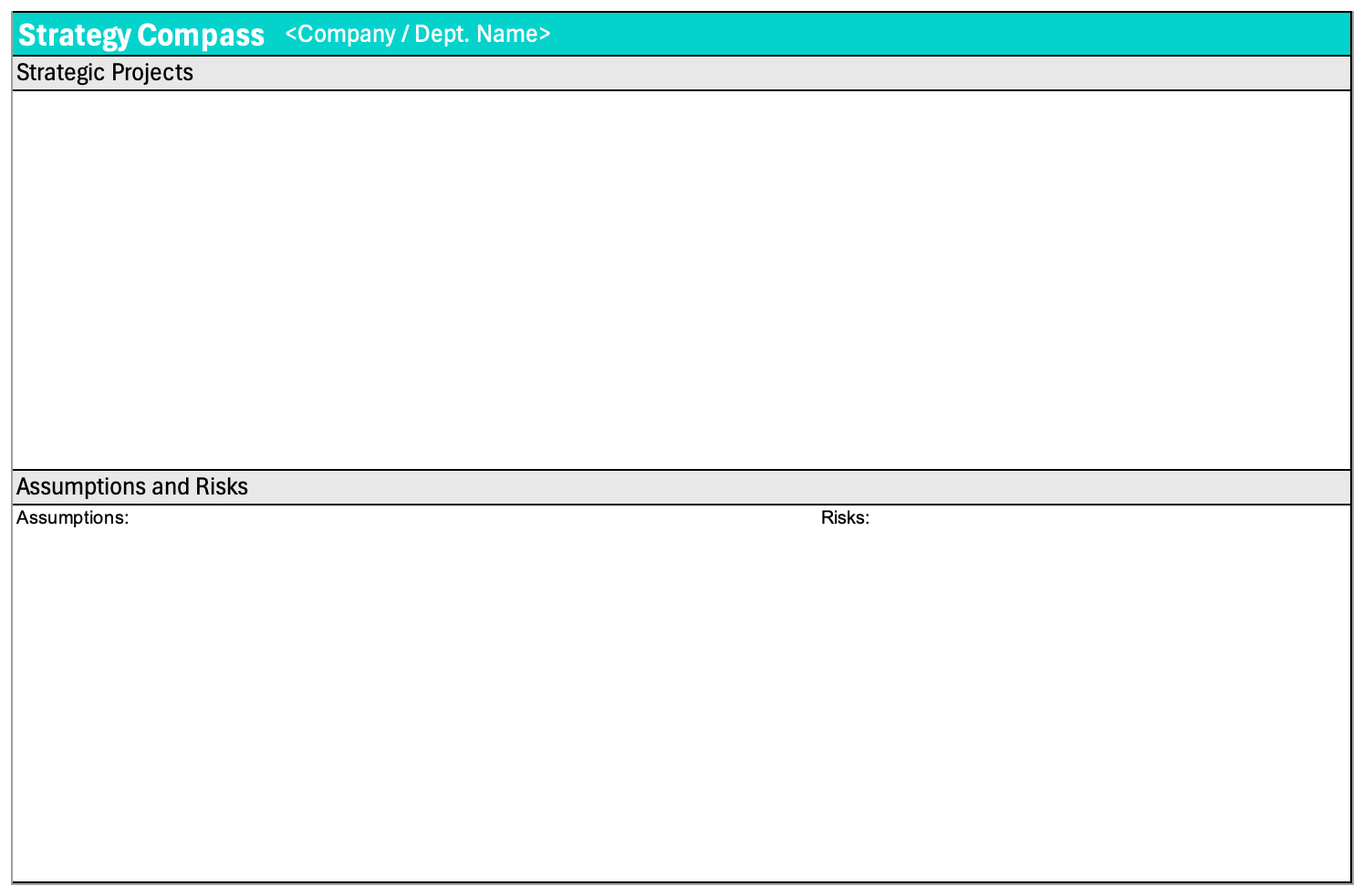The Strategy Compass Framework
Thought Experiment:
What is 'strategy' to you? Can you say what your strategy is? If you lead a team or organization, do others understand the strategy as clearly as you?
"If you don't know where you are going, you might wind up someplace else." -Yogi Berra.
Strategy is a concept that, for many, conjures up feelings of ambiguity, complexity, or even intimidation. It’s a vital tool for business success, yet crafting a clear, compelling, and actionable strategy often feels out of reach.
Enter the Strategy Compass, a straightforward, one-page tool that demystifies strategy and makes it approachable for anyone—from a CEO leading a global corporation to a manager spearheading a small team. This article introduces the core elements of the Strategy Compass, providing a guide to help you build or refine your strategy and align your organization around it, as well as demonstrating its power through two examples: a global company and a personal goal.
But before we begin, what IS strategy? To us, it's nothing more or less than the combination of decisions taken to achieve success in a chosen endeavour. Simpler pursuits may require simpler strategies, yet all pursuits can have an effective strategy defined using the Strategy Compass. Let's take a closer look.
[If you already have a strategy, get help
putting strategy into action,
battle-testing your strategy, and
enhancing your strategic fitness.]
The Strategy Compass: A Bird’s-Eye View
The Strategy Compass organizes strategy into key components, capturing everything on a single, double-sided A4 page. Each section is designed to guide you through the critical aspects of strategy formulation, ensuring your strategy is comprehensive, cohesive, and actionable.
1. Winning Aspiration
Your strategy begins with a clear and inspiring goal. A winning aspiration is more than a vision—it’s a specific, ambitious, and measurable objective that aligns and energizes your team.
Example: Tesla’s aspiration to “accelerate the world’s transition to sustainable energy” drives every decision and initiative within the company. It's inspiring and broader than just 'sell lots of e-vehicles'.
2. Where to Play
Define the markets, customer segments, products, and geographies where you’ll compete—and, just as importantly, where you won’t.
Example: A startup might focus on serving niche industries within specific regions rather than targeting broad markets dominated by established players.
3. How to Win
Articulate your competitive advantage. Will you compete on cost, quality, service, innovation, or some combination?
Example: Southwest Airlines’ strategy of low-cost, no-frills air travel remains a textbook example of a focused “How to Win” approach.
4. What We Have
Inventory your tangible and intangible resources. What assets, relationships, or capabilities can you leverage to deliver your strategy?
Example: A tech firm may highlight its proprietary algorithms or robust partnerships with leading hardware providers.
5. What We Do
Identify the core activities and processes that support your strategy. These can range from operational efficiencies to unique cultural norms.
Example: Amazon’s mastery of logistics and supply chain excellence is a core pillar of its operational strategy.
6. Objectives, KPIs, and Measures
Break down your winning aspiration into SMART objectives, supported by measurable KPIs and operational levers to track progress and guide decision-making.
Example: A retail chain might set a KPI to increase same-store sales by 10% within 12 months, supported by weekly tracking of foot traffic and conversion rates.
7. Strategic Projects
Identify the major change initiatives required to bridge the gap between your current state and your aspirations.
Example: A manufacturing company might prioritize implementing an ERP system as a foundational project to enhance efficiency and scalability.
8. Assumptions and Risks
Strategy rests on assumptions and faces risks. Recognize them explicitly to adapt proactively as circumstances evolve.
Example: A company assuming stable raw material prices should have contingency plans for market volatility.
What Does That Look Like in Action?
Bringing It All Together
The Strategy Compass transforms strategy from an intimidating, sprawling concept into an organized, actionable framework. By focusing on these interconnected elements, you can:
• Clarify and align your organization’s goals.
• Drive accountability with measurable targets.
• Adapt nimbly to challenges and opportunities.
The Strategy Compass isn’t just a tool—it’s a mindset. It empowers leaders to communicate and execute strategy more effectively, ensuring every team member understands their role in achieving the winning aspiration. The versatility of the Strategy Compass, as seen in these examples, underscores its value across vastly different contexts.
Aligning the Organization
Imagine a terraced rice field, where water flows seamlessly from one level to the next, nourishing each layer below. Similarly, the Strategy Compass enables your strategy to cascade effectively through your organization. By starting at the top—whether at the group, enterprise, or departmental level—it establishes a clear framework of strategic priorities and metrics for subsequent levels. By working progressively downwards, each higher-order Strategy Compass then serves as input for developing aligned, tactical strategies at subsequent layers. This cascading approach ensures consistency, coherence, and alignment across all levels of your organization, driving unified execution of your goals.
Start Crafting Your Strategy Today
Whether you’re crafting your organization’s first strategy, refining an existing one, or focusing on a personal goal, the Strategy Compass is your blueprint for success. It’s time to demystify strategy, take control of your direction, and lead you and your team to new heights.
Pick a goal—big or small—and use the Strategy Compass to chart your path to success. Download a copy of the Strategy Compass to get started today and let us know what you think.
Thought Experiment:
What's your Winning Aspiration?
Strategy in hand, click
here
to learn what to do next,
here
to explore techniques you and your management team can try to battle-test and bulletproof your strategy, and
here
to learn why strategy needs to be part of your weekly routine.
Or contact us with any questions or requests for support. We can help!
Download the Strategy Compass














